When I was given the review code for Etrian Odyssey Nexus, I walked over to the corner of my room where my 3DS lay. I’d barely touched it in the past year. A small layer of dust had settled on its top. Part of the casing was beginning to wear and rub away. Booting it up took twice as long as I had remembered. Even looking at the home screen was a surreal experience — after getting used to the Switch’s minimalistic UI, staring at the badges and custom theming felt like going back in time a few years. It was a New 3DS, but no longer new. I couldn’t help but wonder if this would be the last time I picked up a 3DS to review a game.
It would be a fitting one, too. Plenty of series made big splashes on the 3DS, but Etrian Odyssey is one of the few that felt like it truly blossomed on the system. After launching on the DS over a decade ago, EO brought a deluge of quality dungeon crawlers to the handheld, bringing two numbered entries, two remakes, two Mystery Dungeon spinoffs, and two Persona crossovers — each one of which is of good quality and worth your time. But it seems fitting that this great series of RPGs would have one of the last games to send off the system as it slowly sunsets into the horizon — and true to any celebratory experience, Atlus has pulled out all the stops.
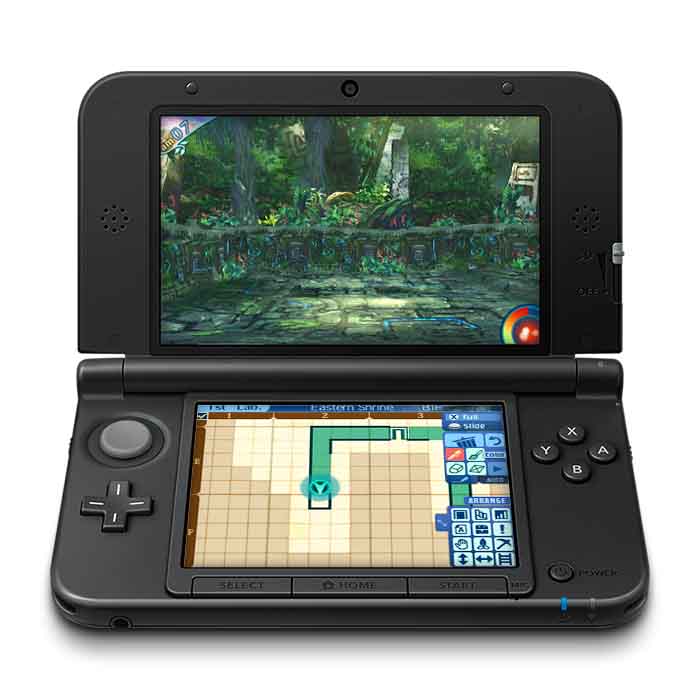
Etrian Odyssey Nexus is, in effect, a “crossover” of all the previous numbered entries in the series, taking classes, labyrinths, enemies and characters from the first through fifth Etrian Odyssey titles and throwing them all together to create a smorgasbord of map-making, dungeon crawling, and trademark Atlus pain. While it feels a bit overstacked with its own meat, there’s no denying that this is the most substantial and epic Etrian Odyssey game out there, marking a fitting conclusion to the series’ presence on a platform that gave it so much life.
EON follows the same basic setup as every Etrian title — you, as a nondescript party of adventurers, arrive in a city (this time around, a flying fortress called Maginia) before venturing off into the unknown, braving labyrinths in pursuit of unraveling the mysteries of the land. Like most Etrian games, the plot is not particularly deep, playing out more like a spirited tabletop RPG than a grand JRPG narrative, with some colorful NPCs and small arcs alongside player-made parties. While the story has never been EO’s strong suit, this time around has the small fortune of bringing back some characters from previous games (like the cackling, money grubbing Napier from EOIII) while generally being a bit more pointed with its characterization, making for some of the series’ more focused writing outside of the Untold games.
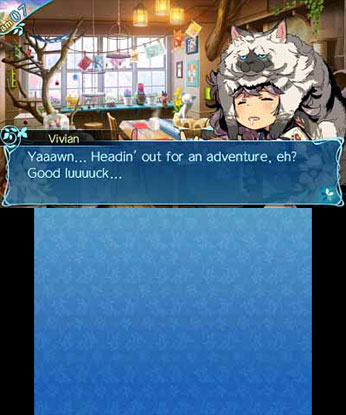
But while the plot may be thin, the timeless quality of making your characters is not. And here’s where EON brings out the big guns: a whopping 19 classes from throughout the series are yours for the picking, each bringing the same sprinkling of customization options found in EOV. While there’s only one new class — the Afterimage-creating, shounen-inspired Hero — it’s made up by the insane number of party combos you can make with the options, as fan faves like EOIV’s Nightseekers, EOII’s Gunners, and like half of the EOIII classes have all made their return with tweaks accordingly. Toss in subclassing and there are literal trillions of different ways to arrange your party, offering countless ways to structure your strategy. Or you could play five Farmers, like a true Etrian fan would.
But while the class variety aspect of character creation is great, so too is the general character design. There’s something immensely charming about seeing Yuji Himukai’s art style progression right on the guild recruitment screen — from the blockier, more cartoonish style of earlier Etrian designs to the current richly detailed and evocative art, with Himukai’s trademark vivid colors and striking shadows present throughout. Their new designs for this game are similarly striking — just look at the way Princess Persephone’s gems glitter, or at Kvasir’s sheer expressiveness, and it becomes clear why Etrian’s art style is one of my favorites.
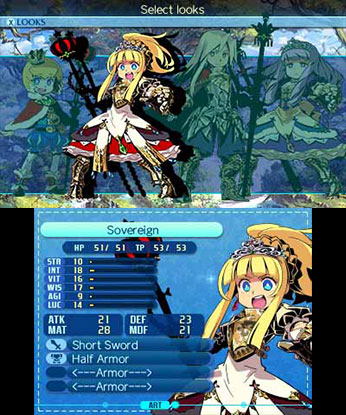
On the audio side of things, Yuzo Koshiro continues his 30 year legacy of being one of the best video game composers out there. Nexus’s greatest crossover appeal is containing samplings and arrangements of his work from throughout the series, and it’s all joyous — from the upbeat Maginia song to somber and majestic labyrinth tracks to the dozens — and I do mean dozens — of bangin’ battle themes. All the standouts are here — The First Campaign, Hoist the Sword and Pride in The Heart, and The End of Raging Waves are all utterly and incomprehensibly roaring. Behind any great game is a great soundtrack, and much like Smash Bros., Nexus uses its crossover status to display the best of its soundwork.
So if the game’s aesthetic is great (if largely cribbed from its forebearers), where does that leave the meat of the game? When it comes to content, Nexus is pretty much a turducken stuffed inside haggis — rich and fatty to the point of almost too much. The average EO game has 25 floors with a five floor aftergame. Nexus has 13 labyrinths of between three to five floors each alongside sprawling side mazes and hundreds of quests. The vast majority are taken from the first through fourth games (none appear from EOV, somewhat strangely) alongside a good helping of new shrines.
At first I was wary of the fact that the game was essentially reappropriating old EO levels wholesale, but it quickly becomes clear that while they’re visually and conceptually similar, a lot of level designs are reworked and remixed. Veterans may get surprised by certain tricks the devs pull, and take comfort in seeing other mechanics come back. It also gives the devs a chance to take another crack at strata that had good ideas but flawed execution in the past (lookin’ at you, Golden Lair!), and the game feels less like it’s recycling content so much as taking the concepts of the past and going further with them.
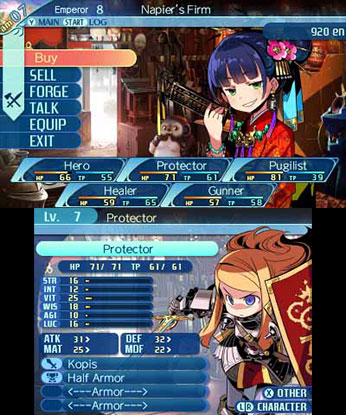
What does feel like recycling content, somewhat surprisingly, are the game’s new labyrinths. There’s only a small handful, but they all play off the same basic idea (two tiers of platforms) and all share the same aesthetic except for the very last one. It’s not absolutely repetitive — they manage to take that one idea and run with it quite far — but compared to the lush variety found in many other labyrinths, it feels a bit more plain.
The battle system, on the other hand, is anything but plain. Etrian Odyssey is one of the greatest purveyors of turn-based combat still in the business, and they excel at it in subtle ways that show how the format can still be fun, engaging, and rewarding. Between weapon/elemental weakness, status ailments, buffs/debuffs, and binds (which disable certain moves depending on which body part is tied up), there’s just as much room for strategy as ever. It deftly avoids the “Mash A to clear battles” problem, balances the strength of classes well, and is not afraid to kick you to the curb if you go in unprepared. But EO is not unfair (well, most of the time) — you and enemies often play by the same basic rules. It’s just a matter of exploiting your resources more effectively than they exploit theirs.
Of course, an Etrian Odyssey game wouldn’t be complete without its more iconic elements. Map-making has returned, with the optional streamlined nature of EOV’s system to help those who lack cartography skills. FOEs — giant, formidable minibosses that show up on the map — remain a fantastic game design element, giving you the option of puzzling out a way to sneak past them or dueling it out in a grueling, taxing fight. And the series’ streak of fantastic boss fights continue, as they bring back some old classics and introduce some new menaces.
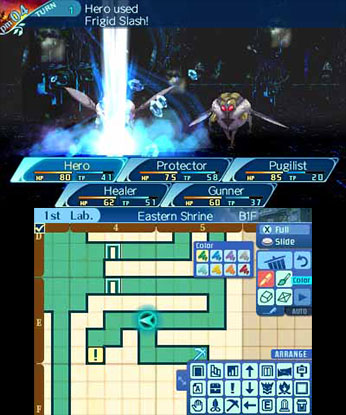
If anything, the game has perhaps a little too much going for it at times. The average EO game runs maybe 40 hours or so tops — my EOV run, for example, clocked in at 34 hours. This one ran for 70, and that’s not counting a decent number of side quests I skipped over (and the entire postgame!). While a lot of labyrinths are at a manageable three-floor size that keeps them lean and the content varied, the ones that go for five-floors feel a bit grueling and elongated at times. Taken at an easier pace you’ll get a huge amount of bang for your buck, but don’t expect to binge the game without some burnout.
There’s some other of the usual EO issues too. The plot, as mentioned, is thin, yet simple and inoffensive enough. Environments still are kinda weird and pixelly and retro, and maybe the only thing that makes me want to see the series on a more modern console. There’s only Japanese VA, which isn’t a huge deal, but it does mark the first time in my memory that the series hasn’t had an English dub. And there are some gratuitous difficulty spikes — one boss towards the end of the game took me over six hours to beat, and I’m almost mad at how I was still invested and satisfied when I finally felled him. If you played a previous Etrian game and didn’t like it, there’s not much here to convince you to give it another go.
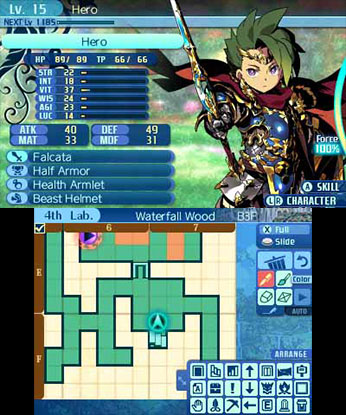
But playing Nexus, I remembered not just how good the series is, but how good the 3DS was as a console. Etrian Odyssey really knows how to use the console’s features to the fullest — drawing the map is smooth and intuitive, all the buttons are used efficiently… hell, even the 3D is good, making it one of the few games I would recommend giving the feature a solid try even if you’re usually not into it. Other franchises have departed to the Switch by now, but there’s a reason Etrian has hung onto the DS line from which it originated.
For me, Etrian Odyssey Nexus isn’t just the end of an era for a solid series of dungeon crawling RPGs — it’s the end of an era for one of the best consoles in Nintendo history, a beautiful swan song for features that made it a portable machine with power. In the eight years of its existence, there have been just as many Etrian Odyssey games made. And while Fire Emblem or Zelda may have had greater titles on the console, nothing will ever harken back to the 3DS quite like making five adventurers and sending them out into the maze to get their stuff jacked by squirrels.
For all this pontification, Nexus isn’t even the technical last entry in the series on 3DS — Persona Q2 is confirmed for NA this June, which will almost certainly be its true final farewell. Both Etrian Odyssey and Nintendo portables will continue on after this; the latter already established, the former likely to metamorphosize into something new and different. It’s their last dance, and Nexus dazzles and stuns with grace and poise. But I don’t know if this Atlus series will ever find a partner quite as complementary ever again, and that’s a bittersweet feeling.
Leave a Comment
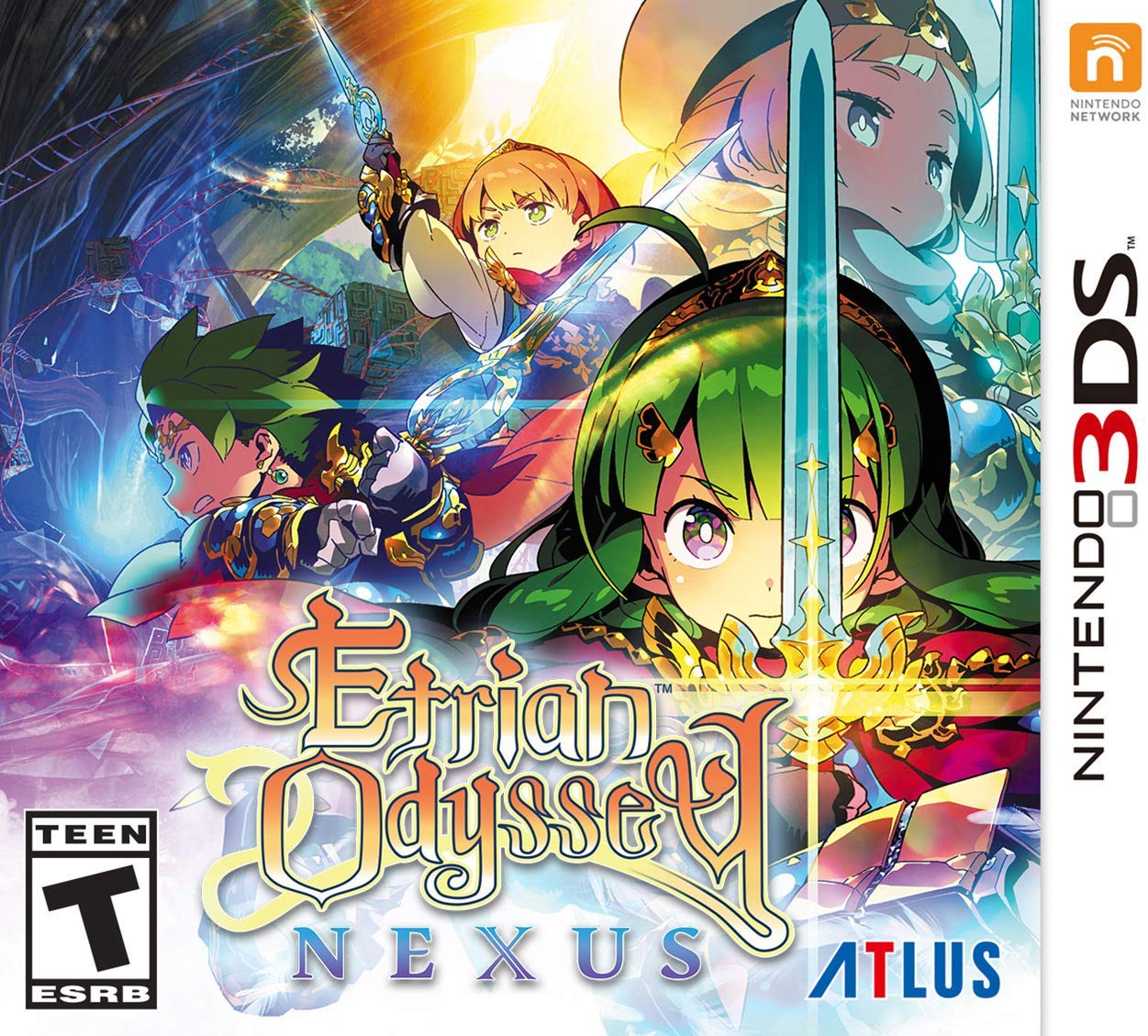
System: Nintendo 3DS
Release Date: February 5, 2019
Category: Role-Playing
Publisher: Sega
Developer: Atlus


